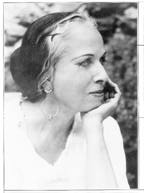Born to Dance
By Gretchen Giles
A YOUNG GIRL GROWS UP in the privileged prosperity of a bustling Mexican rancho in the 1920s. Her father the senator is a traditionalist, a wealthy rancher and military official. The girl is a charmer, dreamy and slight, hoping one day to be a dancer. Her father sternly refuses, not wanting a daughter of his to flaunt herself publicly on the stage. She persists and cajoles until he relents. And relents in a grand way, building a private studio on his grounds and flying teachers in from Anna Pavlova's company and the Paris Opera to instruct his loved one on the rigors of the barre.
This is not a scene from a magic realist novel by writer Isabel Allende (after all--there is no levitation or telekinesis), but the very real story of Ballet Folklorico de Mexico's founder, Amalia Hernández.
A bright, strong-willed girl, Hernández, now 78, chafed at the restrictions of the European style of classical dance. The music, for one, did not stir her soul. Ah, but the music of her country, with its mellifluous rhythms distinct to each territory, rich in tradition and tale, those were the sounds to move to. And so Hernández did what any smart, creative, and hopelessly optimistic young woman would have done 44 years ago--she started her own company.
Today Hernández is la dama grandiosa of Mexican dance. Her company is Mexico's cultural ambassador to the rest of the world, and she has shepherded some 600 dancers across her stage and studio workrooms. Having created more than 40 distinct ballets, she continues to carry the sole burden of the choreography and historical research, as well as traveling with the company when it makes its extensive worldwide tours. One such tour is due to sweep across the Luther Burbank Center's stage on Sept. 11.
Using classically trained dancers who rarely perform a plié once their apprenticeship is done, Hernández bases her work on the revered folkloric and dance traditions of her country. "The folklore in Mexico is very rich," Hernández says by phone from her home in Mexico City. "There are classical ballet companies all over the world, and the Mexican ballet, well, there's only one. I use the classic ballet as the technique. Only the technique, but not the choreography. All the choreography is based on the style and the roots of Mexican folklore."
Famous for its extravagant costumes and sets, the Ballet Folklorico de Mexico embodies age-old traditions wrought from 60 territories of the Mexican states. This latest tour focuses on two distinct examples of dance from the state of Chihuahua. The first half demonstrates the lore of the indigenous Tarahumaras, a mountain people known for developing beautiful, deeply seen dances based on the mating rituals and joyful movements of forest animals in the spring. "It's a very difficult life for them now," Hernández says of the Tarahumaras, "but they have been a very powerful ethnic race, and that's one of the reasons [that I chose them]--for the religious power that they have."
The second half of the program features the dances of the Norteña Polka. Brought to Mexico from Poland by way of Spain, traditions like the polka underscore what Hernández has said previously about her homeland: "Mexico's culture is a concentration of the world's art."
Now she says, "These kind of dances in Mexico have big influences. Don't you think that the American dances of Texas have the same influences? You will realize that in this country we have the same influence."
WEARIED by a nagging cold, Hernández is reluctantly beginning to feel her age. "I am very old," she half-whispers as she suppresses a cough. With her two daughters firmly entrenched in the Folklorico organization, and her grandson heading up operations, Hernández has seen to it that her dream remains a family affair. But infirmity, the thin altitude and smog of Mexico City, and the inexorable march of time haven't stopped her from continuing to explore her creative urges--in the heat of an August morning, Hernández is planning for the holidays.
"I go from one side to the other," she says of her health. "Because I love to choreograph, and I love the authentic folklore, well, when I feel fine and strong, I rush to [work]. I am working on a new ballet of Christmastime in Mexico. I used the portraits of all the angels and birds of the 16th and 17th centuries, and it's coming out well." Researching the piece herself, Hernández continues to travel to museums throughout her country hunting down images and lore that will add to the ballet.
Attempts to find someone to carry her choreographic vision onward have ended lucklessly. Now she waits for her grandchildren to finish growing into the role. "I have tried with many, many other people, and it was such a failure," she says sadly. "I was so disappointed, so I decided to go on myself. I wanted to rest, and I have tried to find people and guide them, but they were very, very lazy. They did not study enough. They didn't rehearse enough."
Stating that "I think that I have material for many years," Hernández sees her gift as one coming straight from God. In fact, she asserts, she truly was born to dance. "I think so," she affirms, "because otherwise I couldn't keep this strength or power for creating. I think that it's a force from above."
[ Sonoma | MetroActive Central | Archives ]
This page was designed and created by the Boulevards team.

Profile of success: Amalia Hernández still choreographs dances for the company she started in 1952.
Ballet Folklorico de Mexico founder Amalia Hernández fulfills her destiny
The Ballet Folklorico de Mexico performs Wednesday, Sept. 11, at the LBC. 50 Mark West Springs Road, Santa Rosa. 7:30 p.m. $20-$30. 546-3600.
From the August 29-September 4, 1996 issue of the Sonoma Independent
Copyright © 1996 Metrosa, Inc.
![[MetroActive Stage]](/gifs/stage.gif)